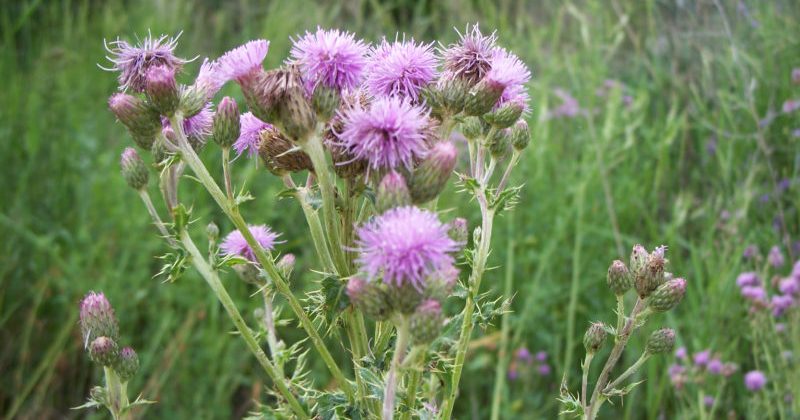AB Direct - Steers
Rail: ---
AB Direct - Heifers
Rail: ---
US Trade- Steers
Rail: 290.00 (IA)
US Trade - Heifers
Rail: 290.00 (IA)
Canadian Dollar
0.02

Four tips for optimal Canada thistle control using herbicide
This is the first in a two-part series on weed control in pastures. The second part, focusing on the role of rotational grazing in controlling Canada thistle, will be available next week on ABP Daily.
It’s the most common weed found in pasturelands on the Canadian Prairies, and it can seriously reduce forage availability if not controlled.
With a deep, creeping root system and a prickly exterior that deters grazing, it’s no surprise that Canada thistle can quickly take over a pasture.
“There’s a lot of compelling reasons to do something about this particular plant,” said Edward Bork, professor of rangeland ecology and management at the University of Alberta, speaking at a webinar hosted by the Alberta Forage Industry Network in early May.
Bork started researching integrated weed control in pastures in 1999, focusing on strategies such as the use of herbicide, fertilizer, and rotational grazing. His early studies showed that increased thistle abundance leads to a negative yield loss of forage biomass.
“After the most extreme scenarios, our yield losses peaked at a ratio of one to two, which basically means if you have one kilogram per hectare of thistle, you’re losing two kilograms of forage,” said Bork.
Pasture conditions also factor into how much this weed can negatively impact forage yield. In a pasture with greater resources, for example, “from an ecological perspective, we can consider the Canada thistle a passenger in the plant community,” Bork explained. “It’s just sitting there filling vacant niches or gaps within the grassland and is not really competing directly with our forage component.”
On the other hand, even a small amount of thistle could have a major impact on a dry, upland pasture with less nutrients and water available, as the weed outcompetes the forage for these limited resources.
While Bork spoke about Canada thistle control, many of these principles apply to other types of weeds. Here are four key tips on integrated Canada thistle control in pastures using herbicide:
Herbicide + fertilizer = greater weed control.
Following his work on the impact of Canada thistle on forage yield, Bork and his team conducted research trials on the effectiveness of different herbicides on thistle, as well as the impact of fertilizer application paired with herbicide treatments. They found that combining herbicide and fertilizer treatments led to a greater reduction of thistle biomass.
“If you make the decision as a producer to go out and control a hard-to-kill perennial weed like Canada thistle and you time that with a pasture fertilization treatment, it means you’re going to get greater long-term suppression of the weed population,” said Bork.
“That’s strictly through a competitive imbalance that’s created through fertility by fertilization, which basically makes your grasses more productive—larger leaf area, more canopy, larger root systems—and that makes them more competitive and in turn suppresses the weed itself, which means you can make your herbicide not only more effective, but last longer.”
But using fertilizer alone will cause more problems.
As Bork’s herbicide efficacy trials illustrate, applying fertilizer to an area with thistles without herbicide treatment is only going to result in more weeds.
For example, in the untreated plots that were fertilized, “the weed infestation went from a little over 1,300 kilograms per hectare all the way up to close to 1,700, and that was a significant increase,” he explained.
“If you go out and you think you’re doing the right thing by fertilizing your pasture, but you’ve got an existing weed population, that weed is going to rob you of many of your nutrients, and it’s going to turn into a bigger infestation.”
You may be waiting a while for legumes to re-establish.
It’s important to consider the impact herbicides may have on legumes, as many bioactives will remove them along with the weeds. Bork was involved in a study on how long it takes for the concentration of herbicide levels in the soil to decrease enough for legumes to re-establish in Alberta’s growing conditions.
Many of the existing studies on this topic took place in the southern United States, where legumes could be re-established 10 to 14 months after spraying herbicides. However, Alberta’s short growing season limits the microbial breakdown of herbicides, making this a much longer process, even with the lowest application rate.
“Our conclusion was that at least in the northern temperate grasslands that we have here in Alberta, our legumes are very, very sensitive,” said Bork.
“Even after 26 months in the field, we were still seeing a reduction in legume emergence…So if you apply these bioactives, you are going to be waiting for quite a period of time before you could expect to get legumes naturally recovering.”
Herbicide wiping is an option, but don’t do it with glyphosate.
Bork’s research also included weed control trials using herbicide wiping, in which the product is applied directly onto the tallest weeds for a more targeted application. While he recommends this as an effective weed control option, he cautions against using a glyphosate product with this method.
“If you have any grasses embedded in there and you apply glyphosate to those grass stems, you are going to get…very significant grass mortality,” he said.
The trials using Roundup, for example, resulted in a forage biomass reduction of 40 to 50 per cent, he reported.
“It doesn’t matter how much grazing pressure you have leading up to the wiping; as long as you get a certain amount at even a trace amount of chemical onto a few grass plants, it can have a very negative impact on the understory.”
Leave a Comment
Add abpdaily.com to your home screen
Tap the menu button next to the address bar or at the bottom of your browser.
Select ‘Install’ or ‘Add to Homescreen’ to stay connected.



Share this article on
About the Author
Piper grew up on a purebred cow-calf operation in Southern Alberta, and she studied English and history at the University of Alberta and journalism at the University of King's College. She has written for industry publications for more than a decade and is currently the Digital Content Specialist for Alberta Beef Producers.